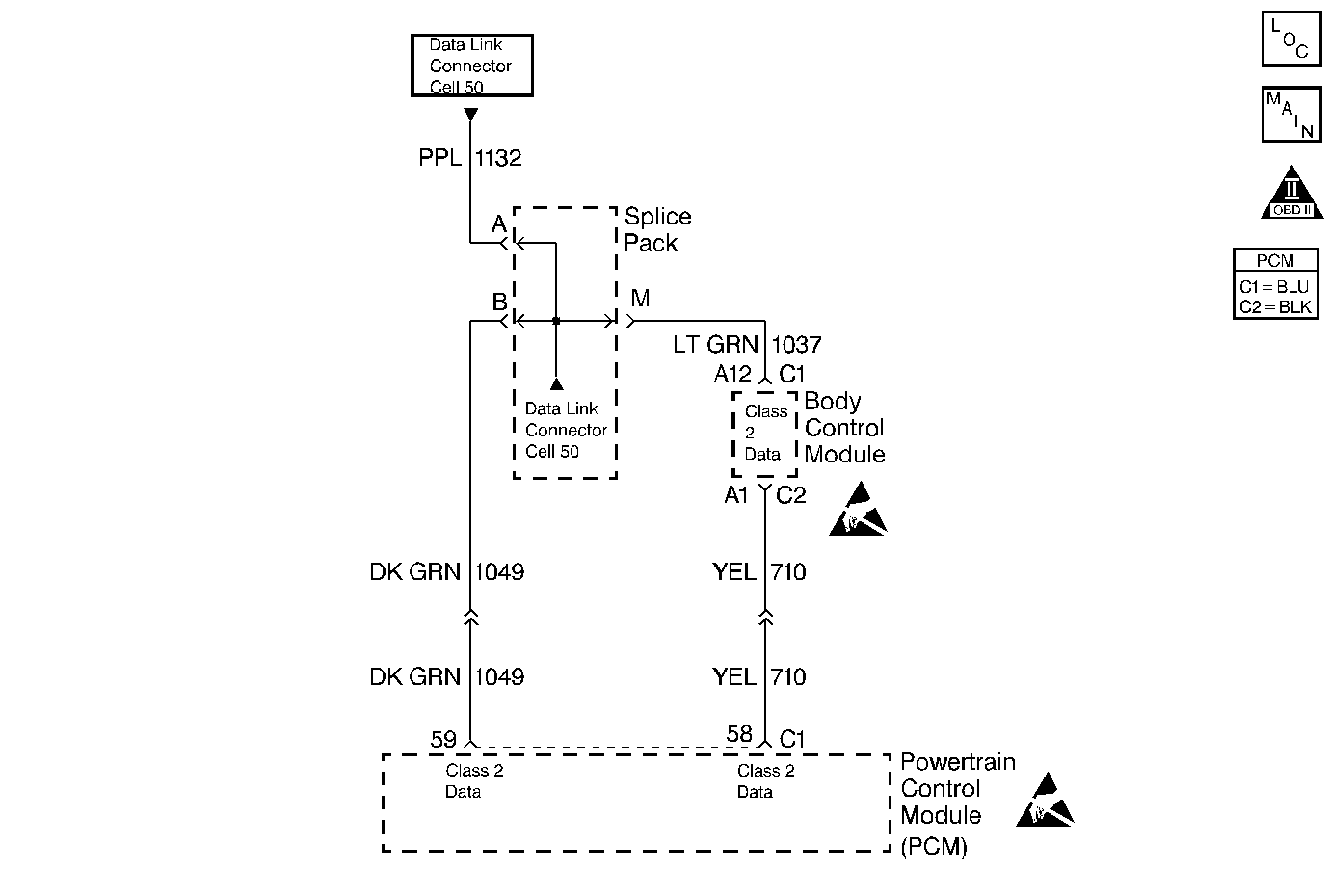
Circuit Description
The Class 2 serial data circuit is used to communicate between the PCM and the Vehicle Theft Deterrent (VTD). The VTD (Passlock) system is located within the Body Control Module (BCM).
The BCM sends a Vehicle Security Password when its ignition switch is rotated into the crank postion. The Vehicle Security Password includes either a Fuel Continue or a Fuel Disable Password. When the Passlock portion of the VTD system has sensed the proper operation of the ignition switch and lock (switch and lock are not tampered with), the Passlock system transmits a password to thePCM. The PCM enables fuel delivery if this password matches the password stored in the PCMs memory. However; if communication is lost or a VTD failure occurs (during an ignition cycle that the PCM has enabled fuel) the PCM will enter a fail-safe mode: Fail Enable (VTD System Failure with Fuel Enabled). The PCM remains in Fail Enable mode, for the current and future ignition cycles, until the fault is corrected and a valid pass word is received, or until battery power is removed. If the battery power is removed while the PCM is in the Fail Enable mode (ignition ON or OFF) the PCM disables fuel delivery. The vehicle will not start, or it will start then stall.
When the PCM receives an invalid password or no password, before the Fuel Disable Decision Point, the PCM disables fuel delivery.
Conditions for Setting the DTC
The PCM has lost communication with the Body Control Module (BCM) after the PCM received a Theft Passed message from the BCM.
Action Taken When the DTC Sets
| • | The PCM will record operating conditions at the time the diagnostic fails. This information will store in the Freeze Frame and Failure Records buffers. |
| • | A history DTC stores. |
Conditions for Clearing the MIL/DTC
| • | A history DTC will clear after 40 consecutive warm up cycles without a fault. |
| • | A scan tool can clear the DTCs. |
Diagnostic Aids
Attempting to start the vehicle by bypassing the Passlock ll system or by substituting parts without performing the password learn procedure may set a DTC P1631 and a P1632.
If no password is received, a DTC U1064 and P1632 may be set.
An intermittent may be caused by a poor connection, a rubbed through wire insulation, or by a wire broken inside the insulation.
Thoroughly check any suspected circuitry for the following items:
| • | Backed out terminals or improper mating |
| • | Broken locks |
| • | Improperly formed or damaged terminals |
| • | Poor terminal to wiring connections |
| • | Physical damage to the wiring harness |
| • | Corrosion |
Test Description
The number(s) below refer(s) to the step number(s) on the Diagnostic Table.
-
The Powertrain OBD System Check prompts you to complete some of the basic checks and to store the freeze frame and failure records data on the scan tool if applicable. This creates an electronic copy of the data captured when the fault occurred. The scan tool stores this data for later reference.
-
A scan tool that cannot display the PCM data indicates that a short exists on the serial data circuit.
-
Because of the internal link of the serial data circuits within the PCM, it is necessary to disconnect the PCM electrical connector in order to determine which serial data circuit or the module that the short is in.
-
If the serial data circuit to the Body Control Module (BCM) was not open, this indicates that the serial communication loss to the PCM lies within the BCM. Refer to the Body Control Module portion of the service manual for Passlock diagnosis.
-
If the serial data loss occurred after a good theft password has been received, the PCM will allow the vehicle to start on following attempts. After making the necessary repairs to the vehicle, reprogram the replacement PCM and complete the password learn procedure and the crankshaft position system variation learning procedures in order to allow the theft system to operate properly. Refer to the Password Learn portion of the service manual for the reprogramming procedures.
-
If no malfunctions are present at this point and no additional DTCs were set, refer to Diagnostic Aids for additional checks and information.
Step | Action | Value(s) | Yes | No |
|---|---|---|---|---|
1 | Did you perform the Powertrain On-Board Diagnostic (OBD) System Check? | -- | ||
Install a scan tool. Was DTC U1064 also set? | -- | |||
3 | Has any part of the vehicle theft deterrent system been tampered with? | -- | ||
Is the action complete? | -- | -- | ||
5 | Does the BCM indicate that the password is valid? | -- | ||
6 | Reprogram the PCM. Refer to Powertrain Control Module Replacement . Is the action complete? | -- | -- | |
7 | Check for BCM DTCs and make any necessary repairs. Is the action complete? | -- | ||
Does the scan tool indicate that this diagnostic ran and passed? | -- | |||
Check to see if any additional DTCs are set. Does the scan tool display any DTCs that you have not diagnosed? | -- | Go to the applicable DTC table | System OK. Go to Diagnostic Aids |
